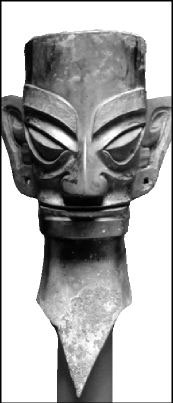YOU CAN ENJOY this show on a lot of different levels. There’s gold—practically a requirement for major special exhibitions these days; there’s a romantic back-story with touches of Indiana Jones; there’s the sheer exotic beauty of the objects on view, resembling nothing you’ve ever seen before. But for people who know a little about Chinese history, ancient and modern, the most interesting thing about the show is that it’s happening at all.
The very word “history” has special significance in China. Modern-day Greeks are proud that Homer wrote in Greek, but nobody believes that the Iliad is history, in the sense of a literal record of events. Similarly, sophisticated Chinese smile at the idea that a semidivine ruler named Huang Di (the Yellow Lord) invented all the basics of civilized life, from the calendar to the art of spinning silk.
Likewise, it’s generally conceded that the emperors of the Xia Dynasty, if they existed at all, did not rule China in peace and plenteous harmony from 2205 to 1766 B.C. precisely as legend would have it. Still, even today, Chinese history is inextricably tied up with the notion of dynasties. As historians of England talk about their ephemeral Plantagenets, Tudors, and Stuarts, Chinese children learn to think of their nation’s proud 3,500-year history in terms of the families who successively ruled it under the will of Heaven—Shang, Zhou, Han, et al.
Fifty years of Communist indoctrination have barely dented this traditional way of looking at things, and for good reason. The Chinese way of interpreting history is deeply conservative—anyone who manages to hold on to power obviously does so through the will of Heaven, so shut up and get back to work—and deeply triumphant as well.
According to the traditional view, it was all but foreordained that thanks to its inherent cultural superiority, China—meaning Chinese language, art, politics, and science—would expand southward and westward from roots in the lower Yellow River valley around 1500 B.C. until it came to rule all of Asia, from the eastern ramparts of Tibet to the typhoon-swept South China Sea. The tradition came in handy when Mao’s dialectical materialists attempted to justify the Chinese takeover of Tibet and trans-Amur Siberia: different dynasty, same inevitable historical process.
Even if you didn’t buy into the official “Civilization—Made in China” dogma, it was hard to argue with; Chinese imperial archivists have been in charge of East Asian record-keeping for over 2,500 years, so their version of history is the only version we’ve got. Even the archaeological record, which has poked holes in so many fond national traditions, seemed to back up the Chinese claim to priority and superiority in all things. Until 1986.
ON JULY 18, 1986, workmen excavating clay for brick-making in central Sichuan Province came across chunks of carved jade in their pit and reported their discovery to archaeologists surveying the area for ancient settlement sites. By the end of the day, the diggers had turned up enough stuff to revolutionize our picture of East Asian cultural history.
Some of these objects are going on show now in Seattle, many for the first time. The bulk of them are masks—though made of weighty bronze, so probably not designed for casual Halloween wear—like the one pictured here, but there are also life-size statues of human figures, highly realistic images of birds (some seated in spidery, fantastical “trees” up to 12 feet high), as well as jade objects and elephant tusks. And, except for a very few obviously imported from far away, like the tusks, none of the pieces found resemble in the slightest “Chinese art” of the same period: the 12th century B.C.
Prehistoric artifacts found in a remote region only a couple hundred miles from Tibet show no stylistic allegiance to Shang Dynasty bronzes created at the same time a thousand miles to the east? No surprise there, you’d think. But according to the art history party line, Shang bronzes are unique, created at a time when the rest of what was to become “China” was bathed in illiterate darkness.
The Sichuan bronzes pose a delicate problem for scholars eager to study them. Ideologically, China has loosened up in many ways in recent years, but “Chinese culture” is still a major prop to the national self-image. So it’s still not easy for old-guard keepers of the flame to acknowledge that while the founders of their culture were crafting eerily abstract ritual vessels, people a thousand miles away in “barbaric” Sichuan were using identically sophisticated bronze-casting techniques to produce robust representational art for totally different purposes.
SAM curator Jay Xu walks a fine line in his catalog essays for the show: On the one hand, the Sichuan bronzes are referred to as “Shang dynasty period”; on the other, their total, refreshing freedom from the least bit of Chinese influence is evident as well. What’s more, the catalog makes clear that this astonishing discovery isn’t due to mere luck. Hampered by political upheaval and sheer lack of cash, China has barely begun a broad-scale survey of its archaeological resources. At present, the wonders of the dig at Sanxingdui stand out like a single bright but enigmatic candle in the dark. But it is only a matter of time until more such discoveries are made. As they are, the monolithic myth that is “China” will inevitably crumble. But, as is already happening in the wake of “post-modern” reevaluations of the Western tradition, among the ruins an even richer harvest will grow.








